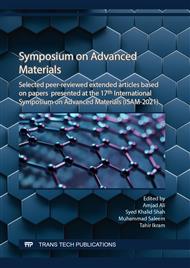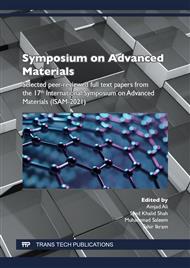[1]
G. M. O. A. Bandyopadhyay, Physical aging of epoxy polymers and their composites Polymer physics, J. Polym Phy. 24 (2011) 1695-1716.
DOI: 10.1002/polb.22384
Google Scholar
[2]
M. I. L. K. Dušek, Curing of epoxy resins. Statistics of curing of diepoxides with diamines, J. Polym. 53 (1975) 239-240.
DOI: 10.1002/polc.5070530107
Google Scholar
[3]
A. C. L. A. G. S. Springer, Curing of Epoxy Matrix, J.comp mater. 17 (1982)173-176.
Google Scholar
[4]
H. K. D. M. Howard Kuhn, ASM Metal Hand Book -Mechanical Testing and Evaluation, ASM International, Ohio, (2007).
Google Scholar
[5]
R. O. &. R. R. Asep Bayu Dani nandiyanto, How to read and interpret FTIR spectroscope of Organic Materials, Indonesian J. of sci & Tech. 4 (2019) 97-118.
DOI: 10.17509/ijost.v4i1.15806
Google Scholar
[6]
S. Z. M. c. S. C. C. l. a. Z. R. Goran Nikolic, Fast Fourier Transform IR Characterization of Epoxy GY Systems Crosslinked with Aliphatic and Cycloaliphatic EH Polyamine Adducts, Chem Mater. Sci. 20 (2010) 1424-8220.
DOI: 10.3390/s100100684
Google Scholar
[7]
A. Barbosa, A. Fulco, E. Guerra, F. Arakaki, M. Tosatto, M. Carolina, D. Melo, Accelerated againg effets on carbon fiber/epoxy composites, Comp. 110 (2011) 298-306.
DOI: 10.1016/j.compositesb.2016.11.004
Google Scholar
[8]
A. CedeñoChong S. PaikSung, Fluorescence and IR characterization of epoxy cured with aliphatic amines, Poly. 46 (2005) 9378-9384.
DOI: 10.1016/j.polymer.2005.04.063
Google Scholar
[9]
O. Yılmaz1, Ç. Özkan1, C. Yılmaz, A. Yorgancıoğlu1, H. Özgünay, H. Karavana, Synthesis and characterization of functional Acrylic copolymers via RAFT Mini-Emulsion Polymerization, ICMEAS, 23 (2017) 1236-1241.
DOI: 10.1063/1.5018501
Google Scholar
[10]
A. Nandiyanto, R. Oktiani, R. Ragadhita, A. Sukmafitri, R. Zaen, Amorphous content on the photocatalytic performance of micrometer-sized tungsten trioxide particles, Arab. J. Chem. 13 (2020) 2912-2924.
DOI: 10.1016/j.arabjc.2018.07.021
Google Scholar
[11]
G. Dovbeshko, N. Gridina, E. Kruglova, O. Pashchuk, FTIR spectroscopy studies of nucleic acid damage, Talanta, 53 (2000) 233-246.
DOI: 10.1016/s0039-9140(00)00462-8
Google Scholar
[12]
A. Hoshino, K. Fujioka, T. Oku, M. Suga, Y. Sasaki, T. Ohta, M. Yasuhara, K. Suzuki, and K. Yamamoto, Physicochemical Properties and Cellular Toxicity of Nanocrystal Quantum Dots Depend on Their Surface Modification, Nano lett. Tokyo, Japan, (2004).
DOI: 10.1021/nl048715d
Google Scholar



